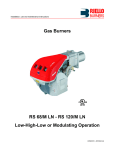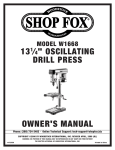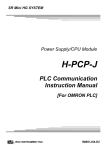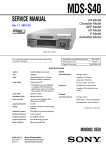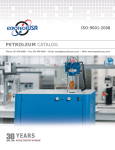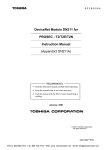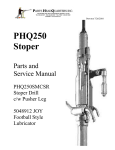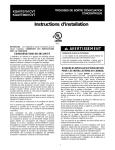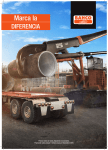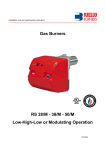Download Siemens LFL Series Technical data
Transcript
Installation, use and maintenance instructions Gas Burners RS 160/M LN Low-High-Low or Modulating Operation C6505073 - 2915849 (6) - 05/2009 WARNING CONTENTS TECHNICAL DATA . . . . . . . . . . . . . . . . . . . . . . . . . . . . . . page Burner models . . . . . . . . . . . . . . . . . . . . . . . . . . . . . . . . . . . . . . . Accessories . . . . . . . . . . . . . . . . . . . . . . . . . . . . . . . . . . . . . . . . . Burner description . . . . . . . . . . . . . . . . . . . . . . . . . . . . . . . . . . . . Packaging - Weight . . . . . . . . . . . . . . . . . . . . . . . . . . . . . . . . . . . Max. dimensions . . . . . . . . . . . . . . . . . . . . . . . . . . . . . . . . . . . . . Standard equipment . . . . . . . . . . . . . . . . . . . . . . . . . . . . . . . . . . . Firing rates . . . . . . . . . . . . . . . . . . . . . . . . . . . . . . . . . . . . . . . . . . Minimum furnace dimensions. . . . . . . . . . . . . . . . . . . . . . . . . . . . Commercial boilers. . . . . . . . . . . . . . . . . . . . . . . . . . . . . . . . . . . . Gas pressure . . . . . . . . . . . . . . . . . . . . . . . . . . . . . . . . . . . . . . . . 3 3 3 4 4 4 4 5 5 5 6 If you smell gas: • • • • Do not touch any electrical items. Open all windows. Close all gas supply valves. Contact your local gas authority immediately. Do not store flammable or hazardous materials in the vicinity of fuel burning appliances. Improper installation, adjustment, alteration, service or maintenance can cause property damage, personal injury or death. Refer to this manual for instructional or additional information. Consult a certified installer, service representative or the gas supplier for further assistance. INSTALLATION . . . . . . . . . . . . . . . . . . . . . . . . . . . . . . . . . . . . . . 7 Boiler mounting . . . . . . . . . . . . . . . . . . . . . . . . . . . . . . . . . . . . . . 7 Blast tube length . . . . . . . . . . . . . . . . . . . . . . . . . . . . . . . . . . . . . 7 Securing the burner to the boiler . . . . . . . . . . . . . . . . . . . . . . . . . 7 Ignition pilot adjustment . . . . . . . . . . . . . . . . . . . . . . . . . . . . . . . . 7 Combustion head adjustment. . . . . . . . . . . . . . . . . . . . . . . . . . . . 8 Gas piping . . . . . . . . . . . . . . . . . . . . . . . . . . . . . . . . . . . . . . . . . . 9 Adjustments before first firing. . . . . . . . . . . . . . . . . . . . . . . . . . . 10 Servomotor. . . . . . . . . . . . . . . . . . . . . . . . . . . . . . . . . . . . . . . . . 11 Burner starting . . . . . . . . . . . . . . . . . . . . . . . . . . . . . . . . . . . . . . 12 Maximum output. . . . . . . . . . . . . . . . . . . . . . . . . . . . . . . . . . . . . 12 Minimum output . . . . . . . . . . . . . . . . . . . . . . . . . . . . . . . . . . . . . 12 Intermediates outputs. . . . . . . . . . . . . . . . . . . . . . . . . . . . . . . . . 12 Air pressure switch . . . . . . . . . . . . . . . . . . . . . . . . . . . . . . . . . . . 13 High gas pressure switch . . . . . . . . . . . . . . . . . . . . . . . . . . . . . . 13 Low gas pressure switch . . . . . . . . . . . . . . . . . . . . . . . . . . . . . . 13 Flame present check . . . . . . . . . . . . . . . . . . . . . . . . . . . . . . . . . 13 Maintenance. . . . . . . . . . . . . . . . . . . . . . . . . . . . . . . . . . . . . . . . 14 Procedure to refer burner operating condition in high altitude plants . . . . . . . . . . . . . . . . . . . . . . . . . . . . . . . . . . . . . . . 15 Siemens LFL control sequence of operations . . . . . . . . . . . . . . 16 Siemens LFL controltroubleshooting guide . . . . . . . . . . . . . . . . 17 Factory wiring diagram -burner mounted LFL . . . . . . . . . . . . . . 18 Field wiring diagram - burner mounted LFL . . . . . . . . . . . . . . . . 19 Factory wiring diagram - remote panel. . . . . . . . . . . . . . . . . . . . 20 Spare parts list . . . . . . . . . . . . . . . . . . . . . . . . . . . . . . . . . . . . . . 22 Burner start up report . . . . . . . . . . . . . . . . . . . . . . . . . . . . . . . . . 25 Burner shall be installed in accordance with manufacturers requirements as outlined in this manual, local codes and authorities having jurisdiction. 2 TECHNICAL DATA MODEL RS 160/M LN MAX. Output (1) kW MBtu/hr kW MBtu/hr MIN. Fuel - max. delivery - pressure at max. delivery (2) 1032 - 2065 (1847 *) 3521 - 7046 (6302 *) 333 1136 Natural gas 7046 7 SCFH “ WC Operation Standard applications Ambient temperature Combustion air temperature Main power supply (+/-10%) Fan motor Low - high or modulating Boilers: water, steam, thermal oil 32 - 104 (0 - 40 °C) 140 (60 °C) 208 - 230/460/575/3/60 3400 4000 - 5.5 208 - 230 / 460 / 575 15.8 - 9.1 - 6 120 V - 1 x 7 kV 1.6 A - 23 mA 5500 NEMA 1 83.1 °F °F max V/Ph/Hz rpm W - HP V A V1 - V2 I1 - I2 W max Ignition transformer Electrical power consumption Electrical protection Noise levels (3) dBA (1) Reference conditions: Ambient temperature 68 °F (20 °C) - Barometric pressure 394” WC - Altitude 329 ft. (2) Pressure at test point 17)(A)p.4, with zero pressure in the combustion chamber, with open gas ring 2)(B)p.6 at maximum burner output (3) Sound pressure measured in manufacturer’s combustion laboratory, with burner operating on test boiler and at maximum rated output. * Firing rate for C-UL Canadian Listing (CNL) Burner models designations: Model Code Voltage Flame safeguard RS 160/M LN C9544000 (3788070) C9544001 (3788075) C9744000 (3788073) C9744001 (3788073) 208-230/460/3/60 575/3/60 208-230/460/3/60 575/3/60 Burner mounted Burner mounted In an auxiliary panel (see Accessories) In an auxiliary panel (see Accessories) ACCESSORIES (optional): • Available auxiliary panels Control panel code Flame safeguard type 3010332 Fireye 3010336 Landis 3010338 Honeywell • TUBES KIT (see page 5): cod. 3010249 • GAS TRAIN ACCORDING TO UL STANDARDS: see page 9. Important: The installer is responsible for the supply and installation of any safety device(s) not indicated in this manual. 3013980: Thermal overload for 460 V power supply. 3 BURNER DESCRIPTION (A) 1 2 3 4 5 6 (A) Combustion head Ignition electrode Screw for combustion head adjustment High gas pressure switch Sleeve Servomotor controlling the gas butterfly valve and the air damper (by means of a variable profile cam mechanism). When the burner is stopped the air damper will be completely closed to reduce heat loss. 7 Plug-socket on flame rod cable 8 Extensions for slide bars 16) (supplied by kit) 9 Motor contactor and thermal overload with reset button 10 Power switch for different operations: automatic - manual - off Button for: Power increase - power reduction 11 Terminal strip for electrical connection 12 Pilot burner attachment 13 Flame safeguard with lock-out pilot light and lock-out reset button 14 Flame inspection window 15 Low air pressure switch (differential operating type) 16 Slide bars for opening the burner and inspecting the combustion head 17 Gas pressure test point and head fixing screw 18 Air pressure test point 19 Flame sensor probe (flame rod) 20 Air damper 21 Air inlet to fan 22 Screws securing fan to sleeve 23 Gas input pipework 24 Gas butterfly valve 25 Boiler mounting flange 26 Flame stability disk 27 Pilot burner D2791 A B C lbs 523/4“ 281/2“ 3029/32“ 198 (B) Two types of burner failure may occur: • FLAME SAFEGUARD LOCK-OUT: if the flame relay 13)(A) pushbutton lights up, it indicates that the burner is in lock-out. To reset, press the pushbutton. • MOTOR TRIP: release by pressing the pushbutton on thermal overload 9)(A). D36 PACKAGING - WEIGHT (B) - Approximate measurements • The burners are shipped skid mounted. Outer dimensions of packaging are indicated in (B). • The weight of the burner complete with packaging is indicated in Table (B). MAX. DIMENSIONS (C) - Approximate measurements The maximum dimensions of the burners are given in (C). Bear in mind that inspection of the combustion head requires the burner to be opened by withdrawing the rear part on the slide bars. The maximum dimension of the burner, when open is give by measurement I. D1702 A B C D E F (1) G H I (1) L M N O 2613/16“ 1413/32“ 1213/32“ 2127/32“ 3331/32“ 1411/16“-1913/16“ 811/16” 1615/16” 5649/64”- 6231/64” 921/64” 529/32” 75/16” 2” (1) Blast tube: short - long (with kit) (C) 4 STANDARD EQUIPMENT 1 - Gas train flange 1 - Flange gasket 4 - Flange fixing screws 1 - Burner head gasket 4 - Screws to secure the burner flange to the boiler: 1/ 2 W x 13/8” 1 - Cap for combustion head 1 - Disc for combustion head 1 - Instruction booklet 1 - Spare parts list FIRING RATES (A) RS 160/M LN Combustion chamber pressure “WC During operation, burner output varies between: • MAXIMUM OUTPUT, selected within area A, • and MINIMUM OUTPUT, which must not be lower than the minimum limit in the diagram. RS 160 /M LN Important The FIRING RATE area values have been obtained considering an ambient temperature of 68 °F (20 °C), and an atmospheric pressure of 394 “WC and with the combustion head adjusted as shown on page 8. Note: The FIRING RATE areas given in figure (A) have been reduced by 10% with respect to the maximum range that can be reached. Consult Procedure on page 15 to refer burner operating condition in high altitude plants. Firing rate for C-UL Canadian Listing (CNL) MINIMUM FURNACE DIMENSIONS (B) 6302 MBtu/hr (A) D2798 Diameter (inches) Recommended furnace dimensions = 1136 MBtu/hr = 333 kW The firing rates were set in relation to certified test boilers. Figure (B) indicates the diameter and length of the test combustion chamber. Example: Output 2579 MBtu/hr: diameter = 23.6 inch; length 6.6 ft Length (feet) COMMERCIAL BOILERS (C) - IMPORTANT The RS 160/M LN burner is suitable for operation on either flame-inversion boilers* or boilers with combustion chambers featuring flow from the base (three flue passes) on which the best results are obtained in terms of low NOx emissions. The maximum thickness of the boiler’s front door must not exceed 10” (see fig. C). (B) D2919 10” max D1079 (C) 5 (*) For flame inversion boilers, a kit is available to reduce CO emissions if required. The kit includes 5 gas pipes, identical to the other 5 already fitted to the burner head. In standard conditions, the burner head is fitted with a second group of pipes, with gas outlet in a different direction with respect to the others. With this Kit, the second group of pipes is replaced, so that all the pipes are the same. After fitting the kit, ensure they work correctly by measuring the CO and flue gases emissions. GAS PRESSURE The adjacent diagram shows minimum pressure losses along the gas supply line depending on the maximum burner output operation with natural gas. Δp [“WC] Column 1 Gas manifold pressure measured at test point 1)(B), with: • Combustion chamber at 0” WC; • Burner operating at maximum output; • Combustion head adjusted as indicated in diagram (C)p. 8. (A) D3188 Calculate the approximate maximum output of the burner as follows: - subtract the combustion chamber pressure from the gas pressure measured at test point 1)(B). - Find the nearest pressure value to your result in diaram (A). - Read off the corresponding output on the left. Example • Maximum output operation • Natural gas • Gas pressure at test point 1)(B) = 4.09“ WC • Pressure in combustion chamber = 1.18“ WC 4.09 - 1.18 = 2.91“ WC A maximum output of 4094 MBtu/hr shown in diagram (A) corresponds to 2.91” WC pressure. This value serves as a rough guide, the effective delivery must be measured at the gas meter. 1 2 (B) D2441 6 INSTALLATION A 91/16“ B 1225/32“ - BOILER PLATE (A) Drill the combustion chamber mounting plate as shown in (A). The position of the threaded holes can be marked using the burner head gasket supplied with the burner. C 141/2“ 5/8 W (A) D455 BLAST TUBE LENGTH (B) The length of the blast tube must be selected according to the indications provided by the manufacturer of the boiler, it must be greater than the thickness of the boiler door complete with its insulation. The length available, L (inches), is 1411/16“. For boilers with front flue passes 15) or flame inversion chambers, protective insulation material 13), must be inserted between the boiler refractory 14) and the blast tube 12). This protective insulation must not compromise the extraction of the blast tube. For boilers having a water-cooled front, the insulation 13)-14) is not required unless it is required by the boiler manufacturer. SECURING THE BURNER TO THE BOILER (B) Before securing the burner to the boiler, check through the blast tube opening to make sure that the flame sensor probe (flame rod) is correctly set in position, as shown in (C). D2800 (B) Now detach the combustion head from the burner, fig. (B): - loosen the four screws 3) and remove the cover 1); - disengage the swivel joint 7) from the graduated sector 8); - remove the screws 2) from the slide bars 5); - remove the two screws 4) and pull the burner back on slide bars 5) by about 4”; - disconnect the wires from the flame rod and the electrode and then pull the burner completely off the slide bars. Electrode Ignition pilot Probe Secure the flange 11)(B) to the boiler plate, inserting the gasket 9)(B). Use the 4 screws, also supplied with the unit, after first protecting the thread with an anti-locking product. The seal between burner and boiler must be airtight. (C) D2799 If you noticed any irregularities in the positions of the flame rod or ignition electrode during the check mentioned above, remove screw 1)(D), extract the internal part 2)(D) of the head and set up the two components correctly. IGNITION PILOT ADJUSTMENT (D) D1706 MB - Burner terminal strip (E) D2317 7 Place the pilot and electrode as shown in fig. (C). The pilot works correctly at pressures ranging from 5 12” WC. Important To set the pilot without main burner operaton, proceed as follows: - Move the jumper from terminals "30-V11" to terminals "30-VP", as given in fig. (E), this way the main valve is cut out. - With the burner in the manual position, hold the air damper in the minimum position and make the setting. - When the setting is correct, replace the jumper on “30V11”. COMBUSTION HEAD ADJUSTMENT Installation operations are now at the stage where the blast tube and sleeve are secured to the boiler as shown in fig. (A). It is now a very simple matter to set up the combustion head, as this depends solely on the maximum output developed by the burner. It is therefore essential to establish this value before proceeding to set up the combustion head. There are two adjustments to make on the head: • outside air R1; • central air R2. In diagram (C) find the notch for: Outside air adjustment R1 (A) Turn screw 4)(A) until the notch identified is aligned with the front surface 5)(A) of the connector. IMPORTANT: In order to facilitate adjustment, loosen screw 6)(A), adjust and then tighten. D1707 (A) (B) Notches (Air = Gas) Central air adjustment R2 (B) Loosen the 3 screws 1)(B) and turn ring 2) until the notch identified is aligned with index 3). Tighten the 3 screws 1) fully down. Example RS 160 /M LN max. burner output = 5681 MBtu/hr If we consult diagram (C) we find that for this output the adjustments are: • outside air: R1 = notch 8.6; • central air: R2 = notch 0. NOTES • R2 adjustment (diagram C) is an indication only. If possible, always keep the ring nut closed (notch 0); if air recovery is required the nut may be opened following the indications in diagram (C). • Diagram (C) indicates an optimal regulation for a type of boiler seen in fig. (B) page 5. Make sure that the combustion characteristics are satisfactory and free of pulsations. Burner max output (C) D2801 Once you have finished setting up the head, refit the burner to the slide bars 3)(D) at approximately 4” from the sleeve 4)(D) - burner positioned as shown in fig. (B) pag. 7 - insert the flame rod cable and the ignition electrode cable and then slide the burner up to the sleeve so that it is positioned as shown in fig. (D). Refit screws 2) on slide bars 3) after mounting the extension bracket and relative extensions. Secure the burner to the sleeve by tightening screw 1). Reconnect the swivel joint 7) to the graduated sector 6). Connect gas train and pilot train as shown in fig. (A) page 9. Important When fitting the burner on the two slide bars, it is advisable to gently draw out the high tension cable and flame detection probe cable until they are slightly stretched. D2367 (D) 8 GAS PIPING • The main gas train must be connected to the gas attachment 1)(A), using flange 2), gasket 3) and screws 4) supplied with the burner. • The gas train can enter the burner from the right or left side, depending on which is the most convenient, see fig. (A). • The gas safety shut-off valves 5)-6)(A) must be as close as possible to the burner to ensure gas reaches the combustion head within the safety time range. • The pilot gas train must be connected to the gas attachment 5)(A). GAS TRAIN (B) It must be type-approved according to required standards and is supplied separately from the burner. (A) D2846 TYPICAL UL SCHEMATIC GAS PIPING Note See the accompanying instructions for the adjustment of the gas train. KEY (A) 1 - Gas input pipe 2 - Manual valve 3 - Pressure regulator 4 - Low gas pressure switch 5 - 1st safety shut off valve 6 - 2nd safety shut off valve 7 - Standard issue burner with flange gasket 8 - Gas adjustment butterfly valve * 9 - Burner 10 - High gas pressure switch * GAS PILOT LINE * On the burner MAIN GAS LINE (B) D2438 9 LOW GAS PRESSURE SWITCH (A) HIGH GAS PRESSURE SWITCH AIR PRESSURE SWITCH (B) ADJUSTMENTS BEFORE FIRST FIRING Adjustment of the combustion head, and air and gas deliveries has been illustrated on page 8. In addition, the following adjustments must also be made: - Open manual valves up-stream from the gas train. - Adjust the low gas pressure switch to the start of the scale (A). - Adjust the high gas pressure switch to the end of the scale (B). - Adjust the air pressure switch to the zero position of the scale (C). - Purge the air from the gas line. Fit a U-type manometer (D) to the gas pressure test point on the sleeve. The manometer readings are used to calculate the MAX. burner power using the diagram on page 6. (C) Before starting up the burner it is good practice to adjust the gas train so that ignition takes place in conditions of maximum safety, i.e. with gas delivery at the minimum. D2368 (D) 10 SERVOMOTOR The servomotor gives simultaneous regulation of the air damper through the variable cam profile 4)(F) and the gas butterfly valve. It rotates by 130° in approx. 35 s. The factory settings must not be changed for the first firing, just check that they comply with the details below. To open the servomotor, remove the screws and pull the cover outward, fig. (A). CAMS AND TRIM POTENTIOMETERS FUNCTIONS (A) D2277 YES Cam 1: 130° Limits rotation towards maximum for gas. NO Cam 2: 0° Limits rotation towards minimum, air damper closed on stand by. Cam 3: 20° Limits gas ignition position. Cams 4 - 5 - 6 - 7 - 8: not used Don’t release the button indicated in this figure: the syncronization of the cams made in factory would be changed. D2585 Figure above shows how the servomotor is released to manually check (B) there is no binding though its motion. Position jumpers Trim potentiometer MAX Limits maximum modulation. It must be set near the stroke end (cam 1) to exploit as far as possible the variable profile cam and maximum opening of the gas butterfly valve. Trim potentiometer MIN Limits minimum modulation. It must be set near the stroke end (cam 2) to exploit as far as possible the variable profile cam. Trim potentiometer POS Limits an intermediate operating position between MAX and MIN, supplying power to the "P" terminal in the servomotor (through an external command). This function cuts out any external signals. Note Using the slide switch to select MAX or MIN, the servomotor goes into the position for the respective settings of the MAX and MIN TRIM POTENTIOMETERS. Trim potentiometers Slide switch When the settings are complete, place the slide switch on OPE. (C) (D) (E) D2593 1 Servomotor 2 Graduated sector for gas butterfly valve 3 Index for graduated sector 2 4 Adjustable profile cam 5 Adjustment screws for cam starting profile 6 Adjustment fixing screws 7 Adjustment screws for cam and profile (F) D2594 11 BURNER STARTING Position jumpers Close the control circuit, with the switch in fig. C) in the AUTO position. On firing (pilot burner and main valve) turn the switch (C) to MAN and the switch 1)(E) in the AUT position. Trim potentiometers Slide switch (A) (B) (C) D2593 MAXIMUM OUTPUT Using button (B), "increase output" until it stops, app. 130° (cam 1). Place the slide switch on MAX and set the relative MAX trim potentiometer (setting must be very near to 130°) to exploit as far as possible the variable profile cam 4)(D) and have the gas butterfly valve on maximum opening, graduated sector 2) on index 3) fig. (D). The setting of the gas flow must be made on the gas train regulator and, if necessary, on the gas valve. The air setting must be made on the variable profile cam 4)(D) by turning the screws 5), after loosening the screws 6). MINIMUM OUTPUT With the slide switch on the OPE position, use button (B) "decrease output" until it stops at app. 20° (cam 3). Put the slide switch in the MIN position and set the modulation minimum using the relative MIN trim potentiometer. Set the air using the variable profile cam 4)(D). If a lower modulation minimum is required than the level set on cam 3 of the servomotor (20°), decrease the cam setting. INTERMEDIATE OUTPUTS With the switch (C) in the AUTO position, the slide switch in the OPE position and the switch 1)(E) in the MAN position, move the button 2)(E) in various intermediate levels between maximum and minimum and set the variable profile cam 4)(D) to achieve optimum combustion, by turning the screws 5). If possible, do not change the previously set maximum and minimum levels. Check the various setting levels with a combustion analysis. 1 2 3 4 5 6 7 Important Make a progressive adjustment of the profile, without sharp changes. When the setting is complete, lock the cam profile using screws 6)(D). Turn the burner off, release the servomotor as shown in fig. (B) page 11 and manually turn cam 4)(D) to check there is no binding. Servomotor Graduated sector for gas butterfly valve Index for graduated sector 2 Adjustable profile cam Adjustment screws for cam starting profile Adjustment fixing screws Adjustment screws for cam and profile Finally fix the adjustment by turning the screws 6)(D). (D) D2594 1 (E) 2 D791 12 AIR PRESSURE SWITCH (A) AIR PRESSURE SWITCH Adjust the air pressure switch after having performed all other burner adjustments with the air pressure switch set to the start of the scale (A). With the burner operating at min. output, increase adjustment pressure by slowly turning the relative dial clockwise until the burner locks out. Then turn the dial anti-clockwise by about 20% of the set point and repeat burner starting to ensure it is correct. If the burner locks out again, turn the dial anti-clockwise a little bit more. Attention: As a rule, the air pressure switch must prevent the formation of CO. To check this, insert a combustion analyser into the chimney, slowly close the fan suction inlet (for example with cardboard) and check that the burner locks out, before the CO in the fumes exceeds 400 ppm. D2548 (A) HIGH GAS PRESSURE SWITCH The air pressure switch may operate in "differential" operation in two pipe system. If a negative pressure in the combustion chamber during pre-purging prevents the air pressure switch from switching, switching may be obtained by fitting a second pipe between the air pressure switch and the suction inlet of the fan. In such a manner the air pressure switch operates as differential pressure switch. HIGH GAS PRESSURE SWITCH (B) Adjust the high gas pressure switch after having performed all other burner adjustments with the maximum gas pressure switch set to the end of the scale (B). With the burner operating at MAX output, reduce the adjustment pressure by slowly turning the adjustment dial anticlockwise until the burner locks out. Then turn the dial clockwise by 0.8” WC and repeat burner firing. If the burner locks out again, turn the dial again clockwise by 0.4” WC. D2547 (B) LOW GAS PRESSURE SWITCH LOW GAS PRESSURE SWITCH (C) Adjust the low gas pressure switch after having performed all the other burner adjustments with the pressure switch set at the start of the scale (C). With the burner operating at MAX output, increase adjustment pressure by slowly turning the relative dial clockwise until the burner locks out. Then turn the dial anti-clockwise by 0.8” WC and repeat burner starting to ensure it is uniform. If the burner locks out again, turn the dial anti-clockwise again by 0.4” WC. D2547 FLAME PRESENT CHECK (D) The burner is fitted with an ionisation (flame rod) system which ensures that a flame is present. The minimum current for reliable operation is 6 μA (see manufacturers documentation). The burner provides a much higher current, so that controls are not normally required. However, if it is necessary to measure the ionisation current, disconnect the plug-socket 7)(A)p.4 on the ionisation probe cable and insert a direct current microamperometer with a base scale of 100 μA. Carefully check polarities. (C) DA D1711 (D) 13 MAINTENANCE FLAME INSPECTION WINDOW Combustion The optimum calibration of the burner requires an analysis of the flue gases. Significant differences with respect to the previous measurements indicate the points where more care should be exercised during maintenance. Gas leaks Make sure that there are no gas leaks on the pipework between the gas meter and the burner. Flame inspection window Clean the flame inspection window (A). Combustion head Open the burner and make sure that all components of the combustion head are in good condition, not deformed by the high temperatures, free of impurities from the surroundings and correctly positioned. If in doubt, disassemble the elbow fitting 5)(B). (A) Servomotor Disengage the cam 4)(D)p. 12 from the servomotor and turn it backwards and forwards by hand to make sure it moves freely. D709 OPENING THE BURNER Burner Check for excess wear or loose screws in the mechanisms controlling the air damper and the gas butterfly valve. Also make sure that the screws securing the electrical leads in the burner terminal strip are fully tightened. Clean the outside of the burner, taking special care with the swivel joints and cam. Combustion Adjust the burner if the combustion values found at the beginning of the operation do not comply with the regulations in force, or do not correspond to good combustion. Record the new combustion values; they will be useful for subsequent controls. TO OPEN THE BURNER (B): - Switch off the electrical power. - Loosen screws 1) and withdraw cover 2). - Disengage the swivel joint 7) from the graduated sector 8). - Fit the two extensions onto the slide bars 4). - Remove screws 3), and pull the burner back by about 4” on the slide bars 4). Disconnect the probe and electrode leads and then pull the burner fully back. Now extract the gas distributor 5) after having removed the screw 6) and disconnecting the pilot gas line. D2369 (B) TO CLOSE THE BURNER (B): - Push the burner until it is about 4” from the sleeve. - Re-connect the leads and slide in the burner until it comes to a stop. - Refit screws 3), and pull the probe and electrode leads gently out until they are slightly stretched. - Re-couple the swivel joint 7) to the graduated sector 8). - Remove the two extensions from the slide bars 4). - Connect the pilot gas line. 14 PROCEDURE TO REFER BURNER OPERATING CONDITION IN HIGH ALTITUDE PLANTS - Find the corrected burner capacity for the plant’s altitude in chart 1 and the corrected pressure in chart 2. Check in the firing rate graph of the burner (page 5), if the working point defined by the values above is within the range limits. If not, higher burner size is needed. Note Charts are based only on altitude variation (reference temperature = 68°F , 20°C) To get the combined correction in case of different air temperature, a compensation of 1000 ft each 20°F (305 m each 11°C) is applicable. 1 Rated Capacity 500 1000 1500 2000 2500 3000 3500 4000 4500 5000 5500 6000 6500 7000 7500 8000 8500 9000 9500 10000 Average barometric Pressure (20°C) Average barometric Pressure (68°F) 2 Rated Pressure 0,50 1,00 1,50 2,00 2,50 3,00 3,50 4,00 4,50 5,00 5,50 6,00 6,50 7,00 7,50 8,00 8,50 9,00 9,50 10,00 Average barometric Pressure (20°C) Average barometric Pressure (68°F) Example Rated capacity = 3000 MBtu/hr - Rated air pressure = 1.5”w.c. Real altitude = 5000 ft - Real temperature = 108°F Δ = 108°F - 68°F (reference temp.) = 40°F (equivalent 2000 ft variation) Proceeding as descripted above and considering a “virtual altitude” of (5000 + 2000) ft: - the corrected capacity is 3847 MBtu/hr; Burner RS 160/M LN is OK - the corrected burner air pressure is 1.92. CORRECTED BURNER CAPACITY ACCORDING TO ALTITUDE m. a.s.l. ft a.s.l 0 0 494 987 1481 1974 2468 2962 3455 3949 4442 4936 5429 5923 6417 6910 7404 7897 8391 8885 9378 9872 100 328 500 1000 1500 2000 2500 3000 3500 4000 4500 5000 5500 6000 6500 7000 7500 8000 8500 9000 9500 10000 305 1000 512 1023 1535 2046 2558 3069 3581 4092 4604 5116 5627 6139 6650 7162 7673 8185 8697 9208 9720 10231 610 2000 530 1061 1591 2121 2652 3182 3712 4243 4773 5303 5834 6364 6894 7425 7955 8485 9016 9546 10076 10607 Altitude 915 3000 551 1101 1652 2202 2753 3303 3854 4404 4955 5505 6056 6606 7157 7708 8258 8809 9359 9910 10460 11011 1220 4000 571 1142 1713 2284 2855 3425 3996 4567 5138 5709 6280 6851 7422 7993 8564 9135 9705 10276 10847 11418 1525 5000 593 1186 1778 2371 2964 3557 4149 4742 5335 5928 6520 7113 7706 8299 8892 9484 10077 10670 11263 11855 1830 6000 616 1232 1848 2464 3079 3695 4311 4927 5543 6159 6775 7391 8006 8622 9238 9854 10470 11086 11702 12318 2135 7000 641 1282 1924 2565 3206 3847 4488 5130 5771 6412 7053 7694 8335 8977 9618 10259 10900 11541 12183 12824 2440 8000 669 1337 2006 2675 3343 4012 4680 5349 6018 6686 7355 8024 8692 9361 10029 10698 11367 12035 12704 13373 mbar 1013 1000 977,4 942,8 908,2 875,8 843,5 811,85 779,8 747,8 "w.c. 399 394 385 371 358 345 332 320 307 294 CORRECTED BURNER AIR PRESSURE ACCORDING TO ALTITUDE m. a.s.l. ft a.s.l 0 0 0,49 0,99 1,48 1,97 2,47 2,96 3,46 3,95 4,44 4,94 5,43 5,92 6,42 6,91 7,40 7,90 8,39 8,88 9,38 9,87 100 328 0,50 1,00 1,50 2,00 2,50 3,00 3,50 4,00 4,50 5,00 5,50 6,00 6,50 7,00 7,50 8,00 8,50 9,00 9,50 10,00 305 1000 0,51 1,02 1,53 2,05 2,56 3,07 3,58 4,09 4,60 5,12 5,63 6,14 6,65 7,16 7,67 8,18 8,70 9,21 9,72 10,23 610 2000 0,53 1,06 1,59 2,12 2,65 3,18 3,71 4,24 4,77 5,30 5,83 6,36 6,89 7,42 7,96 8,49 9,02 9,55 10,08 10,61 Altitude 915 3000 0,55 1,10 1,65 2,20 2,75 3,30 3,85 4,40 4,95 5,51 6,06 6,61 7,16 7,71 8,26 8,81 9,36 9,91 10,46 11,01 1220 4000 0,57 1,14 1,71 2,28 2,85 3,43 4,00 4,57 5,14 5,71 6,28 6,85 7,42 7,99 8,56 9,13 9,71 10,28 10,85 11,42 1525 5000 0,59 1,19 1,78 2,37 2,96 3,56 4,15 4,74 5,33 5,93 6,52 7,11 7,71 8,30 8,89 9,48 10,08 10,67 11,26 11,86 1830 6000 0,62 1,23 1,85 2,46 3,08 3,70 4,31 4,93 5,54 6,16 6,77 7,39 8,01 8,62 9,24 9,85 10,47 11,09 11,70 12,32 2135 7000 0,64 1,28 1,92 2,56 3,21 3,85 4,49 5,13 5,77 6,41 7,05 7,69 8,34 8,98 9,62 10,26 10,90 11,54 12,18 12,82 2440 8000 0,67 1,34 2,01 2,67 3,34 4,01 4,68 5,35 6,02 6,69 7,35 8,02 8,69 9,36 10,03 10,70 11,37 12,04 12,70 13,37 mbar 1013 1000 977,4 942,8 908,2 875,8 843,5 811,85 779,8 747,8 "w.c. 399 394 385 371 358 345 332 320 307 294 Reference conditions (Charts 1-2): Ambient temperature 68 °F (20 °C) - Barometric pressure 394” WC (1000 mbar) - Altitude 328 ft a.s.l. (100 m a.s.l.) 15 BURNER OPERATION LFL 1.335 Series 01 BURNER STARTING • Load control close. Fan motor starts. • Servomotor starts: 130° rotation to right, until contact is made on cam 1)(A) page 12. The air damper is positioned to MAX. output. • Pre-purge stage with air delivery at MAX. output. • After pre-purge stage, servomotor rotates to left up to the angle set on cam 3)(A) page 12 for MIN. output. • The air damper and the gas butterfly are positioned to MIN. output. • Ignition electrode strikes a spark. • Pilot valve opens. The pilot flame is ignited. • After about 12 s the main flame ignites and starting cycle ends. Full Modulation (A) D2273 Low - High STEADY STATE OPERATION At the end of the starting cycle, the servomotor control then passes to the load control for boiler pressure or temperature. (The control box continues, however, to check that the flame is present and that the air pressure switch is in the correct position.) • If the temperature or pressure is low, the burner progressively increases its output to the MAX. value. • If the temperature or pressure is high, the burner progressively decreases its output to the MIN. value. And so on. • The burner locks out when demand for heat is less than the heat supplied by the burner at min. output. Load control opens. The servomotor returns to the 0° angle limited by contact with cam 2. The air damper closes completely to reduce thermal dispersion to a minimum. Every time output is changed, the servomotor automatically modifies gas delivery (gas butterfly valve) and air delivery (fan air damper). Switching times are given in seconds, in the burner startup sequence. LFL 1.335 Series 01 t1 t2 t3 t4 (B) D2274 30 2 4 20 t5 t6 t7 t8 optional optional 12 4 Legend for the times t1 Pre-purge time with air damper open t2 Safety time t3 Pre-ignition time, short (ignition transformer on terminal 16) t4 Interval between start of t2 and release of valve at terminal 19 t5 Interval between end of t4 and release of load controller or valve at terminal 20 t5 Running time of air damper into OPEN position t6 Running time of air damper into low-flame position (MIN) t7 Permissible after-burn time t8 Interval until OPEN command for the air damper is given FIRING FAILURE If the burner does not fire, it locks out within 2.5 seconds from opening the pilot valve and then within 5 seconds from opening the main valves. BURNER FLAME GOES OUT DURING OPERATION If the flame should accidentally go out during operation, the burner will lock out within 1s. 16 BURNER FAULTS Control program under fault conditions and lock-out indication LFL 1.335 Series 01 In case of any disturbance, the sequence mechanism stops and with it the lock-out indicator. The symbol above the reading mark of the indicator gives the type of disturbance: No start, e.g. because one contact is not closed. Lock-out during or after control program sequence due to extraneous light (e.g. non-extinguished flames, leaking fuel valves, defects in the flame supervision circuit, etc.) Interruption of startup sequence, because the OPEN signal has not been delivered to terminal 8 by limit switch “a”. Terminals 6, 7 and 14 remain under voltage until the fault has been corrected! P Lockout, because there is no air pressure indication at the beginning of air pressure control. Every air pressure failure after this moment in time leads to lock-out, too! Lock-out due to a fault in the flame supervision circuit. Interruption of startup sequence, because the position signal for the low-flame position has not been delivered to terminal 8 by auxiliary switch “m”. Terminals 6, 7 and 14 remain under voltage until the fault has been corrected! 1 Lock-out, because no flame signal is present after completion of the (1st) safety time. 2 Lock-out, because no flame signal has been received on completion of the 2nd safety time (flame signal of the main flame with interrupted pilot burners). Lock-out, because the flame signal has been lost during burner operation. If lock-out occurs at any other moment in time between the start and the pre-ignition which is not marked by a symbol, this is usually caused by a premature, i.e. faulty flame signal, e.g. caused by a self-igniting UV tube. 17 Factory Wiring Diagram RS 160/M LN with burner mounted Siemens LFL control D2332 (A) Field Wiring Diagram RS 160/M LN with burner mounted Siemens LFL control D2333 Motor Connection RS 160/M LN 208 460 V 575 V 230 V F A T25 T20 T15 S AWG 12 12 12 D3686 Wire size when not indicated: AWG18. (B) 18 Factory Wiring Diagram RS 160/M LN with burner mounted Siemens LFL control Continuous fan operation Change the wire connection from terminal 6 to terminal 1, move the jumper from terminals 12-13 to terminals 4-12 and remove the wire from terminal 13 of control box as indicated below. D2878 (C) LAYOUT (A) - (B) - (C) Burner RS 160/M LN PA PG PGM PS RT SM SO SP TA TB Y0 Y10 Y11 Y13 Key to Layouts CMV - Motor contactor DA - LFL Control box HL - High limit H1 - Remote lock-out signal H2 - Burner on signal H4 - Power on signal H5 - Permission ok IN - Burner manual stop switch MB - Burner terminal strip MV - Fan motor OC - Operating control OC2 - High-low control - Air pressure switch Min. gas pressure switch High gas pressure switch Remote lock-out reset Thermal overload Servomotor Ionisation probe (flame rod) Plug-socket Ignition transformer Burner ground Pilot adjustment valve Adjustment valve Safety valve Pilot valve (safety) NOTES • For electrical connection use flexible cables according to local Regulations. • The setting of the thermal overload must be according to the total burner amperage draw. • The RS 160/M LN burners leave the factory preset for: - 208-230 V power supply: only in this case, if 460 V power supply is required, change the fan motor connection from delta to star and change the thermal overload as well (see page 3); - or 575 V power supply; depending on the burner model (see page 3). • The RS 160/M LN burners have been type-approved for intermittent operation. This means they should compulsorily be stopped at least once every 24 hours to enable the control box to check its own efficiency at start-up. Burner halts are normally provided for automatically by the boiler load control system. If this is not the case, a time switch should be fitted in series to IN to provide for burner shut-down at least once every 24 hours. Important note When installing for the first time and after any maintenance work, make sure the gas valves are connected properly to the orange terminals before proceeding to ignite the burner. Insert auxiliary lamps or check, with the aid of a tester, that power is not being supplied to the valves during standby or pre-purging. Burner ignition with the gas valves open during pre-purging may cause an explosive condition. 19 Factory Wiring Diagram RS 160/M LN with auxiliary control panel 20 Layout (A) LAYOUT (A) page 20 Burner RS 160/M LN The flame safeguard is in an auxiliary panel. See the internal electrical systems of the auxiliary panel in order to have the complete wiring diagram. Key to layout B4 - Ionisation probe (flame rod) F1 - Fan motor thermal overload K1 - Fan motor contactor MB - Burner terminal strip MV - Fan motor S10 - Air pressure switch S12 - High gas pressure switch SM - Servomotor T1 - Ignition transformer TB - Burner ground (earth) connection XQ1 - Plug XQ2 - Plug XQ3 - Plug XQ4 - Plug 21 22 23 75 19 22 20 25 21 8 SPARE PARTS LIST 17 30 7 9 31 4 6 12 29 15 40 26 5 28 13 3 74 28 14 32 11 39 37 27 38 43 44 10 73 36 41 33 1 52 2 76 42 35 46 45 16 45 54 53 34 69 51 24 56 65 60 57 65 50 62 65 47 49 70 61 64 65 55 68 18 63 66 58 48 67 72 71 59 C9744000 (3788073)* C9744001 (3788073)* C5360008 3012583 3013684 3003086 3013683 3012553 3013682 3003763 3013090 3012976 3013137 3013126 3012080 3012956 3013001 3012627 3013686 3012948 3013127 3013205 3012955 3012014 3006096 3012343 3006097 3007627 3012934 3012978 3013062 3012979 3012944 3012972 3012587 3003481 3013681 3003891 3012628 3012629 3012959 3013091 3012178 3012631 3013092 3012633 3012634 3013093 C9544001 (3788075) 1 1 2 2 3 3 4 5 6 7 7 8 9 10 11 11 12 13 13 14 15 16 17 18 19 20 21 21 22 23 24 25 26 26 27 28 29 30 31 32 33 34 35 36 37 C9544000 (3788070) N. CODE • • • • • • • • • • • • • • • • • • • • • • • • • • • • • • • • • • • • • • • • • • • • • • • • • • • • • • • • • • • • • • • • • • • • • • • • • • • • • • • • • • • • • • • • • • • • • • • • • • • • • • • • • • • • • • • • • • • • • • • • • • • • • • • • • • • • • • • • • • • • • • • • • • • • • • • • • • • • • • • • • • * = Versione minima - Minimum Version DESCRIPTION DESCRIZIONE AIR DAMPER ASSEMBLY AIR DAMPER ASSEMBLY GRID GRID SOUND DAMPING SOUND DAMPING INSPECTION WINDOW PILOT TUBE FAN OVERLOAD+CONTACTOR 208-230V OVERLOAD+CONTACTOR 575V SWITCH TRANSFORMER U BOLT BAR EXTENSION BAR EXTENSION AIR PRESSURE SWITCH BASE PLATE BASE PLATE CONTROL BOX LFL 1.335 FERRULE GAS REGULATOR SUPPORT FLAT SPRING MEMBRAN COVER MOTOR MOTOR ANCHOR PLATE SERVOMOTOR SHAFT HALF-SHELL SCREW SCREW CONNECTOR BAR BRACKET H.T. LEAD ELECTROD PROBE TUBE AIR DIFFUSER GAS HEAD INTERIOR TUBE SUPPORT GRUPPO SERRANDA GRUPPO SERRANDA PROTEZIONE PROTEZIONE FONOASSORBENTE FONOASSORBENTE VISORE TUBO PILOTA GIRANTE RELE' + CONTATTORE 208-230V RELE' + CONTATTORE 575V INTERRUTTORE TRASFORMATORE CAVALLOTTO PROLUNGA PERNO PROLUNGA PERNO PRESSOSTATO ARIA MENSOLA MENSOLA APPRECCHIATURA LFL 1.335 GHIERA REGOLATORE GAS SUPPORTO MOLLA MEMBRANA COFANO MOTORE 208-230/460V MOTORE 575V PIASTRA SERVOMOTORE ALBERO GUSCIO VITE VITE RACCORDO PERNO STAFFA COLLEGAMENTO ELETTRODO ELETTRODO SONDA TUBETTO TAZZA DISTRIBUTORE TUBO INTERNO SUPPORTO BURNER SERIAL NUMBER MATRICOLA BRUCIATORE ≤ 02356XXXXXX ≥ 02366XXXXXX ≤ 02356XXXXXX ≥ 02366XXXXXX ≤ 02356XXXXXX ≥ 02366XXXXXX ≤ 02356XXXXXX ≥ 02366XXXXXX ≤ 02356XXXXXX ≥ 02366XXXXXX ≤ 02356XXXXXX ≤ 02356XXXXXX C5360002 • • • • • • • • • • • • • • • • • • • • • • • • • • • • • • • • • • • • • • C9744001 (3788073)* • • • • • • • • • • • • • • • • • • • • • • • • • • • • • • • • • • • • • • C9744000 (3788073)* C5332011 3013094 3012637 3012958 3007891 3013095 3012969 3003996 3005482 3012971 3012352 3003841 3012356 3012646 3012594 3012595 3012049 3012639 3012640 3012641 3012642 3012643 3012647 3003322 3013096 3006132 3012644 3012600 3003543 3006098 3012601 3012354 3012358 3012350 3012357 3012602 3012603 3013055 3013010 3013229 3013685 C9544001 (3788075) 38 39 40 41 42 43 44 45 46 47 48 49 50 51 52 53 54 55 56 57 58 59 60 61 62 63 64 64 65 66 67 68 69 70 71 72 73 74 75 76 C9544000 (3788070) N. CODE • • • • • • • • • • • • • • • • • • • • • • • • • • • • • • • • • • • • • • • • • • • • • • • • • • • • • • • • • • • • • • • • • • • • • • • • • • • • • • • • * = Versione minima - Minimum Version DESCRIPTION DESCRIZIONE EXTERIOR TUBE ELBOW PROBE LEAD SEAL CONNECTOR GAS PRESSURE SWITCH PLUG SEAL FLANGE AND ELBOW BAR BEARING SPRING TIE ROD ANCHOR PLATE AIR INTAKE SCREW CONTROL DEVICE SLEEVE BRACKET SHUTTER END CONE CENTERING SUPPORT CONNECTOR MANIFOLD SHAFT AND RING GRADUATE SECTOR TIE ROD TIE ROD PIN JOINT LEVER LEVER CAM LEVER BEARING SUPPORT BAR TUBE CONTROL BOX BASE PLUG PLATES ASSEMBLY TUBO ESTERNO GOMITO COLLEGAMENTO SONDA GUARNIZIONE RACCORDO PRESSOSTATO GAS TAPPO GUARNIZIONE FLANGIA E GOMITO PERNO CUSCINETTO MOLLA TIRANTE PIASTRA BOCCA D'ASPIRAZIONE VITE GRUPPO REGOLATORE CILINDRO STAFFA OTTURATORE IMBUTO FIAMMA BASETTA RACCORDO MANICOTTO ALBERO E ANELLO QUADRANTE TIRANTE TIRANTE SNODO SFERICO LEVA LEVA CAMMA LEVA CUSCINETTO SUPPORTO PERNO TUBO ZOCCOLO SPINA GRUPPO PIASTRE BURNER SERIAL NUMBER MATRICOLA BRUCIATORE ≤ 02356XXXXXX ≤ 02356XXXXXX ≤ 02356XXXXXX ≥ 02366XXXXXX ≥ 02366XXXXXX BURNER START UP REPORT Model number: Serial number: Project name: Start-up date: Installing contractor: Phone number: GAS OPERATION Gas Supply Pressure: CO2: Low Fire High Fire Main Power Supply: O2: Low Fire High Fire Control Power Supply: CO: Low Fire High Fire Burner Firing Rate: NOX: Low Fire High Fire Manifold Pressure: Net Stack Temp - Low Fire: High Fire: Pilot Flame Signal: Comb. Efficiency - Low Fire: High Fire: Low Fire Flame Signal: Overfire Draft: High Fire Flame Signal: OIL OPERATION Oil supply pressure: CO2: Low Fire High Fire Oil suction pressure: O2: Low Fire High Fire Control Power Supply: CO: Low Fire High Fire Burner Firing Rate: NOX: Low Fire High Fire Low Fire Flame Signal: Net Stack Temp - Low Fire: High Fire: High Fire Flame Signal: Comb. Efficiency - Low Fire: High Fire: Low Fire Nozzle Size: Overfire Draft: High Fire Nozzle Size: Smoke number: CONTROL SETTINGS Operating Setpoint: Low Oil Pressure: High Limit Setpoint: High Oil Pressure: Low Gas Pressure: Flame Safeguard Model Number: High Gas Pressure: Modulating Signal Type: NOTES 25 RIELLO S.p.A. I - 37045 Legnago (VR) Tel.: +39.0442.630111 http:// www.rielloburners.com RIELLO BURNERS NORTH AMERICA 1-800-4-RIELLO 35 Pond Park Road Hingham, Massachusetts, 1-800-474-3556 U.S.A. 02043 2165 Meadowpine Blvd. Mississauga, Ontario, Canada L5N 6H6 http://www.riello-burners.com Subject to modifications




























